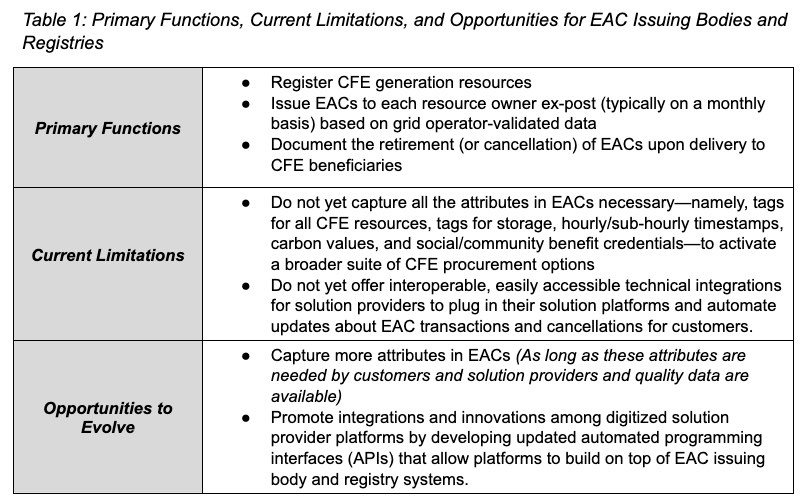Energy Attribute Certificate Issuing Bodies Can Unleash Next Generation Procurement by Capturing More Attributes & Better Serving as a “Platform of Platforms”

The Clean Energy Buyers Institute’s NextGen Activator Workshop series is identifying energy market gaps and changes necessary to help energy customers advance toward and increase the decarbonization impact of their clean energy procurement decisions.
Energy attribute certificate (EAC) issuing bodies and registries are critical stakeholders in the voluntary carbon-free electricity (CFE) market. By updating their centralized database systems to capture more attributes in EACs and allow solution providers to seamlessly synchronize with these systems, EAC issuing bodies and registries will play a central role in enabling the introduction of more CFE procurement options in the market and supporting more actions that lead to grid decarbonization.
Representatives from EAC issuing bodies, registries, and standards bodies that oversee voluntary CFE markets across the globe convened on June 16th for the fourth workshop in the Clean Energy Buyers Institute (CEBI)’s NextGen Activator series to define the specific new attributes, underlying data, and implementation actions needed to introduce CFE procurement options that meet customer-identified next generation procurement objectives.
This workshop generated insights addressing the following three questions:
Question #1: What is the role of EAC issuing bodies and registries in existing and next generation CFE markets?
Insight #1: EAC issuing bodies and registries serve as a linchpin of voluntary CFE markets and can become a “platform of platforms” to better support customer and solution provider needs by updating existing systems.
Customers rely on EACs to assert ownership claims over each megawatt-hour of CFE they procure for auditing, reporting, and marketing purposes. Because EACs possess financial value, customers’ voluntary procurement of EACs (both bundled and unbundled with electricity sales) creates an additional revenue stream for CFE resource owners and sends market signals that help attract greater investments in grid decarbonization.
EAC issuing bodies and registries promote CFE procurement integrity and validation by issuing, tracking, and canceling EACs, which each represent a unique standardized tradeable instrument representing one megawatt-hour of verified CFE generation. They collate the critical details reflected in EACs and track EAC lifecycles to support evidence based CFE procurement.
EAC issuing bodies and registries have the potential to unlock CFE solution innovations that aim to better serve customer needs and decarbonization impact-related goals. Table 1 below summarizes the current functions, limitations, and evolution opportunities of EAC registries and issuing bodies.

Question #2: How should EAC issuing bodies and registries capture new attributes in EACs and gather the underlying data?
Insight #2: EAC issuing bodies and registries should offer new attribute fields in their systems for all CFE resources, storage-related tagging, granular timestamps, grid carbon intensity snapshot, and social/community credentials.
By capturing a specific set of new attributes in EACs, issuing bodies and registries can solve pre-requisite for solutions for six of the eight customer-identified next generation procurement objectives.
Table 2 below summarizes the five new attributes and associated data requirements to update EACs so that they fulfill the needs of next generation procurement solutions. With these updated EACs, customers can then send clearer market signals and increase demand for solutions that promote systemic grid decarbonization.

Question #3: What are the barriers EAC issuing bodies and registries face to add these new attributes and what are ways to accelerate implementation?
Insight #3: EAC issuing bodies and registries track the information they are supposed to track and diverse stakeholders—from energy customers and solution providers to policymakers and regulators—can support EAC issuing bodies and registries in driving updates to these systems.
Depending on the market, EAC issuing bodies and registries have varying data access, capacity, and governance-related flexibility to make decisions independently about capturing new attributes or making technical system updates.
Stakeholders can and should make detailed requests to EAC issuing bodies and registries about which new attributes should be captured, where to collect the underlying supportive data for these new attributes, and what other new technical functionality is needed. In other words, if stakeholders make these types of requests, this will trigger processes to proceed with making these updates. Stakeholder action, particularly by policymakers and regulators, can also help ensure EAC issuing bodies and registries gain needed access to quality data from grid operators and any other key data sources.
Coming up in the NextGen Activator series, CEBI will hold two workshops focused on defining ways to gather needed data and implementation pathways for EAC issuing bodies and registries to ingest these data to capture new attributes in the EACs they issue. CEBI will hold additional NextGen Activator workshops focused on needs, opportunities, and implementation pathways to update customer leadership programs and greenhouse gas accounting frameworks to, respectively, help incentivize and better capture the decarbonization impacts of next generation procurement.
The insights that CEBI gathers from all NextGen Activator workshops will inform robust CEBI NextGen guidance (to be published in late September) that clarifies how to assemble all the puzzle pieces to enable next generation procurement solutions.
